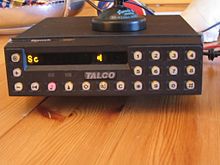Transceiver
A transceiver is a device that has a transmitter and a receiver that share part of the circuitry or are inside the same box. When the transmitter and receiver have no parts in common of the electronic circuit is known as a transmitter-receiver. The term was coined in the early 1920s.
Since certain circuit elements are used for both transmission and reception, the communication provided by a transceiver can only be half duplex, which means that signals can be sent in both directions, but not simultaneously.[ citation required]
Other similar devices are transponders, transverters, and repeaters.
Radio Amateurs
In the early days of amateur radio, receivers and transmitters were built separately. Until the 40s, the custom was that they were made by the radio amateur himself.
Since the 1950s, commercial equipment began to appear, better and less expensive than the equipment made by radio amateurs. Manufacturers like Drake or Collins made lines to harmonize the appearance and performance of the transmitter and receiver.
As of the 1970s, almost all amateur radio transmitters are transceivers (transmitters/receivers). For example:
- so-called Walkie-talkie like those of the norm PMR 446 or FRS
- modern radio equipment
- some homemade transceivers, such as Pixie
Contenido relacionado
EEPROM
Third generation of computers
VRML


